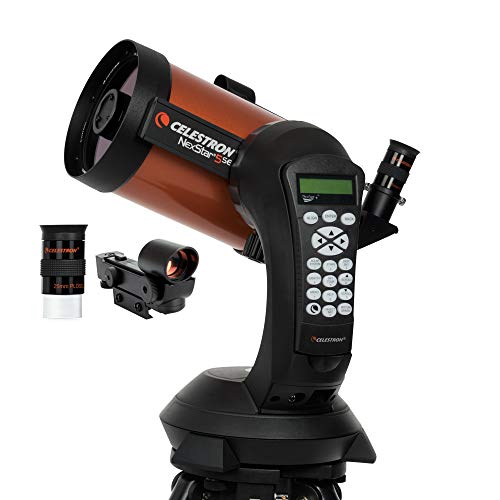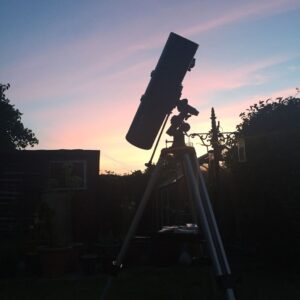This site contains affiliate links to products. I may receive a commission for purchases made through these links.
Pluto is merely 0.02% of the Earth’s mass. For perspective, Pluto’s width – 1,400 miles – is about 50 percent of the width of the United States. Furthermore, the distance from Pluto to the Sun is about 3.6 billion miles. The distance between Mars and the Sun is around 142 million miles.
Due to its size and distance from the Earth and the Sun, you need a telescope with significant power to see Pluto. The telescope must have an aperture size of at least 10 inches. You’ll also need multiple factors to be in your favor, especially low light pollution.
In this article, we share with you what kind of telescope you can use to view Pluto. Additionally, we discuss the factors you must consider and the steps to take when choosing a telescope to observe the dwarf planet.
Can I view Pluto with a telescope?
You can view Pluto with a telescope, but it must have an aperture of at least 10 inches, although an 8-inch telescope will work if all other conditions are perfect. You’ll also need a night with good seeing, irrespective of the size of your telescope.
Good seeing means a clear night sky with low light pollution from the Moon and background stars. It is also a night with low humidity and no clouds. You’ll also need a generous dose of patience to have a shot at seeing Pluto.
What size of telescope is required to observe Pluto?
Pluto’s current visual magnitude is 14.47, which means it is quite dim in the sky. At prime environmental conditions, you would require a telescope with at least 10 inches of aperture. Depending on Pluto’s orbit and magnitude, you may even need a telescope with a minimum 11 inches aperture.
Visual magnitude is how much light celestial bodies in the solar system reflect from the Sun and the intensity of that reflection by the time it gets to the Earth. The visual magnitude of any solar system object depends on its distance from the Sun and Earth.
Planet Pluto is very far from the Sun and the Earth. Less light gets to Pluto from the Sun. After Pluto absorbs some light, it reflects some, too. Because Pluto is far from our planet, the intensity of this reflection weakens before it gets to the Earth.
The visual or apparent magnitude of Pluto ranges between 13.64 to 16.3 depending on where it is in orbit. And the best magnitude the dwarf planet can ever have is 13.64.
This feature of Pluto makes it incredibly hard to see outer planets via telescopes. That is why larger-aperture telescopes are necessary for observing Pluto.
Can I see Pluto with a 10-inch telescope?
A telescope with a 10-inch aperture is a good option to view Pluto. However, it may not appear as more than a speck in the night sky, similar to a faint star. You’ll also need a map to confirm that what you saw was indeed Pluto.
Can I see Pluto with a 5-inch telescope?
You cannot see planet Pluto with a 5-inch telescope. Pluto is at the end of the solar system and is exceedingly dim. A 5-inch telescope does not have the power to overcome these challenges.
If you had asked this question in 1989, the answer would have been “yes.” Pluto had a magnitude of 13.7 then, similar to the brightness of Uranus and Neptune.
You would have been able to use a 4-5-inch aperture telescope to view the dwarf planet. The next chance this is possible would be well beyond 2100.
Even though you cannot see Pluto with a 5-inch telescope, you can use them to see other planets, such as the details on Jupiter, cloud belts on Saturn, Cassini Division in Saturn’s rings, and much more.
One of the best-priced 5-inch telescopes you can get as an amateur astronomer is the Celestron NexStar 5SE Telescope. It has a fully-automated GoTo mount to track and observe planets.
Factors to consider when choosing a telescope for observing Pluto in the night sky
Given the conditions surrounding the dwarf planet, you can’t use just any telescope.
When choosing a telescope for observing Pluto, you must consider its aperture size, magnification capabilities, mount type, and the quality of optics you seek.
Aperture size
If you slightly open a window, only a small breeze can enter the room. But if you open the window to the end, more breeze comes in.
The amount of breeze that enters the room is directly proportional to the window size, assuming you open the window to the end.
Think of aperture size as the size of the window for a telescope. It determines the amount of light that passes through the telescope. In a reflecting telescope, the aperture is the diameter of the primary mirror or the objective lens in a refracting telescope.
Read also: Refractor vs Reflector Telescope: What Is The Difference?
The larger the aperture, the more light the telescope can collect and the clearer the celestial bodies you see.
The aperture size determines many features of the telescope, especially what you can observe, image resolution, and the details you’ll see.
Aperture size also determines the weight and cost of the telescope. So you know if you want to see Pluto, you have to splurge the cash.
Magnification capabilities
The focal length of a telescope contributes significantly to its magnification capabilities. The other factor in the magnification power equation is the focal length of the eyepiece you’re using. The formula for magnification is:
Telescope magnification power = telescope focal length/eyepiece focal length.
This equation means the magnification you’ll enjoy will vary depending on the eyepiece you use since telescopes have fixed focal lengths.
That said, all telescopes have a minimum and maximum useful magnification. Below and beyond this magnification power, the telescope’s performance won’t be optimal.
As a rule of thumb, the minimum useful magnification is 3-4x the telescope’s aperture size in inches. So a 10-inch telescope has a minimum magnification power of 30-40x.
Maximum useful magnification is 50 times the aperture size. The same 10-inch telescope will have a maximum magnification power of 500x. Note that these figures are just estimates.
At a magnitude of 14.47, you’ll need at least a magnification power of 450x to spot Pluto.
You may also like: What Magnification Do You Need To See Planets?
Mount type
A mount serves two primary purposes. The first is to serve as an anchor to secure and stabilize your telescope. Your telescope must be steady and balanced because a slight wobble can impact your observation.
The second purpose is to enable you to move the telescope in the exact direction of the object you want to view. The location of a planetary object is relative to yours. It is necessary to be able to pinpoint your target object with ease. Some mounts are also automated.
You can adjust the mount manually or electronically through an app if it has electric motors. When the mount rotates or adjusts to where the object is, the whole setup must remain sturdy.
There are about five types of telescope mounts, including:
- The Dobsonian mount (Dob)
- The altazimuth mount (Alt-Az)
- The equatorial mount (EQ)
- The computerized GoTo mount
- The Star trackers
The major difference between all these mount types is the movement mechanism. The altazimuth and Dobsonian are similar, except that the latter can carry larger telescopes than the former. They both allow movement across two axes – horizontal and vertical.
The equatorial mount, which comes with most premium telescopes, has one axis in alignment with the Earth’s rotation axis. This setup makes tracking the sky object you want to observe easy. You can also attach motor units to EQ mounts to make them semi-automatic.
Learn more about Alt-Azimuth Mount vs Equatorial Mount in this article.
A computerized GoTo mount is fully automatic. You must enter a few parameters (planetary object, date and time, and geolocation) into the system and complete a three-star alignment.
The equipment takes up the task of pinpointing the object’s exact location. These mounts are pricey and can cost between $4,000-$10,000.
Star trackers are like GoTo mounts, but they are popular in astrophotography.
You may also like: Are GoTo Telescopes Worth It? (My Real Experience).
Quality of the optics
What level of image quality are you okay seeing? You must determine if your spending on the telescope is worth the image you’ll see.
The good news is that even if you buy a telescope for Pluto, it’ll most likely work for most sky objects. You’ll only need to select eyepieces with care.
What kind of telescope can be used to observe Pluto, the dwarf planet?
You can use telescopes with a large aperture from 10 inches and above to see Pluto. Some telescopes with this specification include the Celestron CPC 1100 XLT, Meade LX200-ACF, Orion XT12g, Sky-Watcher Collapsible Dobsonian telescope, and the Celestron StarSense Explorer Dobsonian telescope.
Celestron CPC 1100 XLT, the best mid-priced computerized telescope
The Celestron CPC 1100 XLT ticks all the boxes for a telescope you can use to see Pluto.
For starters, it has an aperture size of 11 inches and a focal length of 2800 mm, which suffices for observing Pluto. You can get a maximum magnification power of around 550x at this size.
Its GoTo mount is heavy and rigid, and this prevents unnecessary vibrations that may ruin your stargazing. The mount also comes with over 40,000 solar system objects in its database to easily track and find objects for you. And the tracking is super accurate, so you can be sure Pluto is at the center of your view.
The Celestron CPC 1100 has an automatic GPS that updates the location and the current date and time.
One particular drawback is that this telescope is heavy (about 28kg), which is not unexpected. The long focal length of 2800 mm leads to a narrow field of view. You may struggle to fit some deep sky objects into your field of view. It is priced at $4,000.
Meade LX200-ACF, the best premium telescope to view Pluto
The Meade LX200-ACF comes in four variants – 8, 10, 12, and 14 inches. Given your intended use, we recommend not going below the 10-inch variant.
The 10-inch variant has a focal length of 2500mm, while the 12-inch and 14-inch variants have focal lengths of 3048mm and 3556mm, respectively.
All the variants have a sturdy computerized Altazimuth-GoTo mount type that you can use to pinpoint over 145,000 solar system objects. The internal GPS makes it easy to quickly and precisely align with stars.
According to Meade Instruments, all the telescopes in this series have a “highest useful magnification” of 300x. The 10-inch telescope has a limiting stellar (visual) magnitude of 14.7, which means you can see Pluto with it.
This set is high-end. These are the top-echelon of premium computerized telescopes.
Orion XT12g, the best bang-for-the-buck value telescope for viewing Pluto
The Orion XT12g is a 12-inch (305mm) aperture telescope with a modest cost for the value it provides. It has a focal length of 1500mm for a focal ratio of f/4.9.
At less than $2,000, you can enjoy good convenience with the GoTo mount helping you locate celestial bodies in the solar system with excellent accuracy. That’s in addition to the EZ Finder II feature, a healthy database of solar system objects, and access to Starry Night.
Rather than having to align with three stars to set up orientation, you can do two with the Orion XT12g.
Compared to other 12-inch telescopes in the market with computerized convenience, you can’t go better than Orion XT12g GoTo Dobsonian telescope.
Sky-Watcher 10″ Collapsible Dobsonian Telescope, the best telescope for beginner astronomers
The manufacturer of the Sky-Watcher 10″ Collapsible Dobsonian telescope recommends it for first-time buyers. We couldn’t agree more, particularly at its price point.
With a 10-inch aperture and a focal length of 1200mm, it has the highest theoretical magnification of 508x. This magnification power is suitable for viewing the deep night sky objects. There’s also the GoTo mount to help you track where sky objects should be, including dwarf planets like Pluto.
The telescope comes with an altazimuth mount that rotates at the push of a button. And the design is such that you do not need counterweight systems to balance the telescope. The collapsible makes it easy to couple and decouple the telescope.
Celestron StarSense Explorer 10″ Dobsonian Telescope, the lightest telescope to view Pluto
The Celestron StarSense Explorer 10″ Dobsonian is a 10-inch telescope with a focal length of 1200mm. Aside from the large aperture, the telescope is light compared to similar scopes.
It has an altazimuth Dobsonian mount and a single-speed Crayford design focuser. It’s also easy to set up and use.
You’ll also have access to the StarSense Explorer app, which makes it easy to align objects to the center of your view.
A few drawbacks of this telescope are the single-speed focuser and the slight imbalance you may experience when you use a heavy eyepiece. Other than that, the Celestron StarSense Explorer 10″ Dobsonian offers tremendous value for money.
How to view Pluto in the solar system?
Timing is vital when you want to find Pluto. So, the first step is planning. You need to pick a time when Pluto is in opposition, and the Earth’s moon is not in the dark skies. You’ll also need to scout the perfect spot from which you’ll be observing.
The next step is to track the dwarf planet. If you have one of the computerized mounts with automatic tracking, your task is easy in this regard. If the reverse is true, you must manually track where it could be.
After spotting what you believe to be the former ninth planet, you need to confirm if it was the dwarf planet you spotted. You’ll need an accurate star chart to make this confirmation.
Takeaway: Former ninth planet with gigantic observation challenge
Pluto may be a dwarf planet, but it’s one of the solar system’s toughest planetary objects to observe. Same as other dwarf planets.
The planet is small and far away, making sighting it a daunting but achievable challenge.
Having a telescope with a big aperture, optimal good seeing conditions, and an accurate star chart to confirm what you saw was Pluto makes the challenge easier. Good luck!
Read also:









